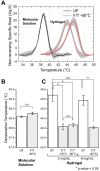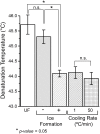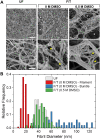Thermal Destabilization of Collagen Matrix Hierarchical Structure by Freeze/Thaw
- PMID: 26765741
- PMCID: PMC4713088
- DOI: 10.1371/journal.pone.0146660
Thermal Destabilization of Collagen Matrix Hierarchical Structure by Freeze/Thaw
Abstract
This study aims to characterize and understand the effects of freezing on collagen structures and functionality. Specifically, thermodynamic destabilization of collagen at molecular- and fibril-levels by combination of low temperatures and freezing were experimentally characterized using modulated differential scanning calorimetry. In order to delineate the effects of sub-zero temperature and water-ice phase change, we hypothesized that the extent of destabilization can be determined based on post-thaw heat induced thermal denaturation of collagen. It is found that thermal denaturation temperature of collagen in hydrogel decreases by 1.4-1.6°C after freeze/thaw while no such decrease is observed in the case of molecular solution. The destabilization is predominantly due to ice formation. Exposure to low temperatures in the absence of ice has only minimal effect. Calorimetry measurements combined with morphological examination of collagen matrices by scanning electron microscopy suggest that freezing results in destabilization of collagen fibrils due to expansion of intrafibrillar space by ice formation. This fibril-level damage can be alleviated by use of cryoprotectant DMSO at concentrations as low as 0.5 M. A theoretical model explaining the change in collagen post-thaw thermal stability by freezing-induced fibril expansion is also proposed.
Conflict of interest statement
Figures






Similar articles
-
Freeze-thaw induced biomechanical changes in arteries: role of collagen matrix and smooth muscle cells.Ann Biomed Eng. 2010 Mar;38(3):694-706. doi: 10.1007/s10439-010-9921-9. Epub 2010 Jan 27. Ann Biomed Eng. 2010. PMID: 20108044
-
Influence of Xanthan-Curdlan Hydrogel Complex on Freeze-Thaw Stability and Rheological Properties of Whey Protein Isolate Gel over Multiple Freeze-Thaw Cycle.J Food Sci. 2015 Jul;80(7):E1498-505. doi: 10.1111/1750-3841.12915. Epub 2015 May 25. J Food Sci. 2015. PMID: 26012512
-
Denaturation of type I collagen fibrils is an endothermic process accompanied by a noticeable change in the partial heat capacity.Biochemistry. 1998 Jun 2;37(22):8147-52. doi: 10.1021/bi980360n. Biochemistry. 1998. PMID: 9609710
-
Role of freezing-induced myofibrillar protein denaturation in the generation of thaw loss: A review.Meat Sci. 2022 Aug;190:108841. doi: 10.1016/j.meatsci.2022.108841. Epub 2022 May 4. Meat Sci. 2022. PMID: 35533633 Review.
-
Freeze/thaw-induced destabilization of the plasma membrane and the effects of cold acclimation.J Bioenerg Biomembr. 1989 Feb;21(1):21-41. doi: 10.1007/BF00762210. J Bioenerg Biomembr. 1989. PMID: 2651425 Review.
Cited by
-
Label-free assessment of carotid artery biochemical composition using fiber-based fluorescence lifetime imaging.Biomed Opt Express. 2018 Aug 6;9(9):4064-4076. doi: 10.1364/BOE.9.004064. eCollection 2018 Sep 1. Biomed Opt Express. 2018. PMID: 30615748 Free PMC article.
-
Thermally-controlled extrusion-based bioprinting of collagen.J Mater Sci Mater Med. 2019 Apr 30;30(5):55. doi: 10.1007/s10856-019-6258-2. J Mater Sci Mater Med. 2019. PMID: 31041538
-
The Texture Change of Chinese Traditional Pig Trotter with Soy Sauce during Stewing Processing: Based on a Thermal Degradation Model of Collagen Fibers.Foods. 2022 Jun 16;11(12):1772. doi: 10.3390/foods11121772. Foods. 2022. PMID: 35741970 Free PMC article.
-
Freezing does not alter multiscale tendon mechanics and damage mechanisms in tension.Ann N Y Acad Sci. 2017 Dec;1409(1):85-94. doi: 10.1111/nyas.13460. Epub 2017 Oct 25. Ann N Y Acad Sci. 2017. PMID: 29068534 Free PMC article.
-
Corneal lenticule storage before reimplantation.Mol Vis. 2017 Oct 27;23:753-764. eCollection 2017. Mol Vis. 2017. PMID: 29123364 Free PMC article.
References
-
- Fratzl P. Collagen: Structure and Mechanics, an Introduction. In: Fratzl P, editor.: Springer; US; 2008. p. 1–13.
-
- Wess TJ. Collagen Fibrillar Structure and Hierarchies. In: Fratzl P, editor.: Springer; US; 2008. p. 49–80.
Publication types
MeSH terms
Substances
Grants and funding
LinkOut - more resources
Full Text Sources
Other Literature Sources

